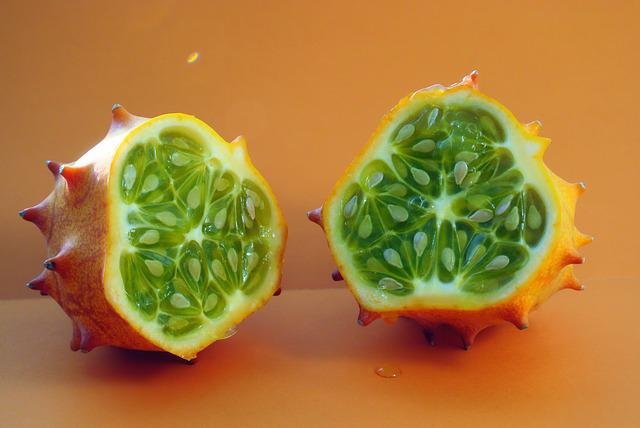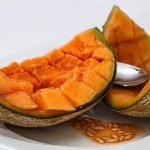
An African fruit with a particular shape, the kiwano has a very tasty pulp reminiscent of other tropical fruits. Its consumption, as a snack or in salads, can have several health benefits.
Kiwano is an exotic fruit typical of Africa. Its scientific name is Cucumis metuliferus and this climbing plant is part of the Cucurbitaceae, the same family to which the more common melon also belongs. In fact, the kiwano is also known by the name of “horned melon”, taking its cue from its particular shape or with the name of “African melon”.
The kiwano plant is a climber and is typical of the area between South Africa and tropical Africa, but for several years it has been marketed in different areas of the world taking advantage of its speed of growth, the extreme ease of cultivation that only requires hot summers and the possibility of storing it for up to 6 months without the use of cold rooms.
The fruit is bright orange when ripe, covered with sharp spikes (hence the name “horned melon”) and gelatinous pulp.
Its beneficial properties on humans and the importance of kiwano consumption for its nutritional properties are now recognized. In this article we will show us the properties most studied by the scientific world and we will tell you where to find it and how to consume it.
Kiwano: calories and nutritional properties
In Italy specific studies have not yet been carried out on this fruit of African origin; however, we can better understand its nutritional properties by exploiting American studies and the data they have collected.
This little fruit is very rich in water and extremely low in calories. 100 g of fruit, in fact, provide less than 50 kcal and its carbohydrate intake is discreet: it therefore presents itself as a perfect snack, also suitable for low-calorie nutritional regimes and aimed at slimming.
The major constituent of kiwano is water (just under 90 g of water per 100 g of fruit): we therefore expect it to be a very thirst-quenching fruit. From the point of view of micronutrients (minerals and vitamins) it appears moderately rich in vitamins: although the concentration of some vitamins is not known, the only appreciable presence is that of vitamin C (100 g of kiwano contain about 5% of the daily requirement of an adult man).
However, kiwano appears very rich in some minerals and in particular in iron and magnesium. As far as iron is concerned, an amount of iron equal to 1.13 mg per 100 g of fruit is indicated, which corresponds to more than 11% of the daily requirement of a man or woman who is not fertile and 6% of the daily requirement of a woman. in childbearing age. Magnesium is even more represented: 40 mg per 100 g of fruit, considered a daily requirement of 240 mg (just under 20%).
We also underline that kiwano appears low in sodium, therefore also suitable for those who, for medical reasons, need to follow low-sodium diets. In a review where the properties of this fruit are analyzed, the high beta-carotene content of kiwano is finally underlined, which is thus one of the main sources of this nutrient for African citizens and the presence in the seeds of good quantities of oleic and linoleic acid. The following table summarizes the nutritional values of this fruit.
Nutritional values per 100g of kiwano:
- Waterfall: 88.97 g
- Power: 44 kcal
- Proteins: 1.78 g
- Lipids: 1.26 g
- Carbohydrates: 7.56 g
- Soccer: 13 mg
- Iron: 1.13 mg
- Magnesium: 40 mg
- Phosphorus: 37 mg
- Potassium: 123 mg
- Sodium: 2 mg
- Zinc: 0.48 mg
- Copper: 0.02 mg
- Manganese: 0.039 mg
- C vitamin: 5.3 mg
- Thiamine: 0.025 mg
- Riboflavin: 0.015 mg
- Niacin: 0.565 mg
- Total folate: 3 ug
- Vitamin A, RAE: 7 ug
Kiwano: the health benefits
Kiwano has long been known for its benefits for human health: this fruit and its extract are in fact recognized antimicrobial, antiviral, antioxidant properties and excellent effects on metabolic health. Let’s explore the most studied benefits of kiwano together.
✓ Antioxidant property
The kiwano fruit contains numerous polyphenols with antioxidant action. These molecules are concentrated in the pulp and to a greater extent in the peel and seeds. The high concentration of these molecules has also allowed the creation of food packaging coated with the extract of kiwano antioxidants. This food packaging is able to slow down the oxidation of foods, such as fresh cut apples or fatty foods.
✓ Hypoglycemic action
In a study performed in mice it was shown that oral administration of kiwano produced a significant reduction in blood glucose levels in animals with hyperglycemia, while no significant effect was obtained in mice with normal blood glucose values. Although further investigation is certainly needed, the consumption of kiwano could be useful in case of hyperglycemia and type 2 diabetes mellitus.
✓ Antiviral and antimicrobial action
Kiwano is known to be a fruit that is resistant to various pathogens. In some studies, plant genes resistant to certain viruses were transplanted into other plants, which thus exhibited the same resistance to the virus. Kiwano extracts have also been used in humans, where it has shown antiviral, antileukemic and antimicrobial activity against the bacterium Salmonella gallinarum.
✓ Gastrointestinal disorders
Among the properties of kiwano there also seem to be beneficial effects on the gastrointestinal system. In particular, kiwano pulp extract has been shown to prevent ulcer formation
Kiwano: how to eat it, how to choose it and how to store it
There are two types of kiwano: an immature, sour fruit with a high content of toxic nutrients and a non-sour fruit, which is the predominantly cultivated one. This fruit, when young, is green in color: in order to eat it we will have to wait for the fruit to ripen: we will notice when it becomes bright orange.
The kiwano on the whole surface of the fruit shows small thorns and inside, however, the pulp remains green and with a mucilaginous consistency. The taste of the kiwano is quite delicate and slightly sweet, with a flavor similar to a mix between banana and pineapple, especially when the fruit is ripe.
If you are wondering how to peel the kiwano fruit, we inform you that it is not necessary to peel it: it will be enough to cut the fruit in two, following the long side and collect the pulp with a teaspoon.
So how do you eat kiwano? Like all fruits, you can taste it raw and enjoy the fruit for a snack. You can also add the pulp collected with a spoon to rich salads or use it to create sauces to accompany meat preparations. Or, again, you can try to use it to prepare extracts with a tropical flavor, perhaps combined with passion fruit, pineapple or other exotic fruits.
This fruit is not easy to find: there are few markets that also offer these types of tropical fruit. Much easier to buy it online, thanks to the presence of different suppliers. If you happen to see it in the stalls of some greengrocer, stop immediately to buy it, you can try it and you will be able to decide whether to order it later!
Contraindications of Kiwano
As for the contraindications of kiwano currently there do not seem to be. In fact, no particular interactions with other drugs are known. Furthermore, as we have already said, being low in salt and a low-calorie fruit, it is well suited to all diets.
Adverse reactions to the fruit cannot be excluded: if you are allergic, be careful the first time you consume it and in case of unwanted effects consult your doctor.






